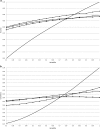Efficiency of genomic prediction of non-assessed single crosses
- PMID: 29180718
- PMCID: PMC5842238
- DOI: 10.1038/s41437-017-0027-0
Efficiency of genomic prediction of non-assessed single crosses
Abstract
An important application of genomic selection in plant breeding is predicting untested single crosses (SCs). Most investigations on the prediction efficiency were based on tested SCs using cross-validation. The main objective was to assess the prediction efficiency by correlating the predicted and true genotypic values of untested SCs (accuracy) and measuring the efficacy of identification of the best 300 untested SCs (coincidence) using simulated data. We assumed 10,000 SNPs, 400 QTLs, two groups of 70 selected DH lines, and 4900 SCs. The heritabilities for the assessed SCs were 30, 60, and 100%. The scenarios included three sampling processes of DH lines, two sampling processes of SCs for testing, two SNP densities, DH lines from distinct and the same populations, DH lines from populations with lower LD, two genetic models, three statistical models, and three statistical approaches. We derived a model for genomic prediction based on SNP average effects of substitution and dominance deviations. The prediction accuracy is not affected by the linkage phase. The prediction of untested SCs is very efficient. The accuracies and coincidences ranged from ~0.8 and 0.5 at low heritability to 0.9 and 0.7 at high heritability, respectively. We also highlight the relevance of the overall LD and demonstrate that efficient prediction of untested SCs can be achieved for crops that show no heterotic pattern, for reduced training set size (10%), for SNP density of 1 cM, and for distinct sampling processes of DH lines based on random choice of the SCs for testing.
Conflict of interest statement
The authors declare that they have no conflict of interest.
Figures

References
-
- Bernardo R. Best linear unbiased prediction of maize single-cross performance given erroneous inbred relationships. Crop Sci. 1996;36:862–866. doi: 10.2135/cropsci1996.0011183X003600040007x. - DOI
-
- Bernardo R. Best linear unbiased prediction of the performance of crosses between untested maize inbreds. Crop Sci. 1996;36:872–876. doi: 10.2135/cropsci1996.0011183X003600040009x. - DOI
Publication types
MeSH terms
Associated data
LinkOut - more resources
Full Text Sources
Other Literature Sources
Research Materials

